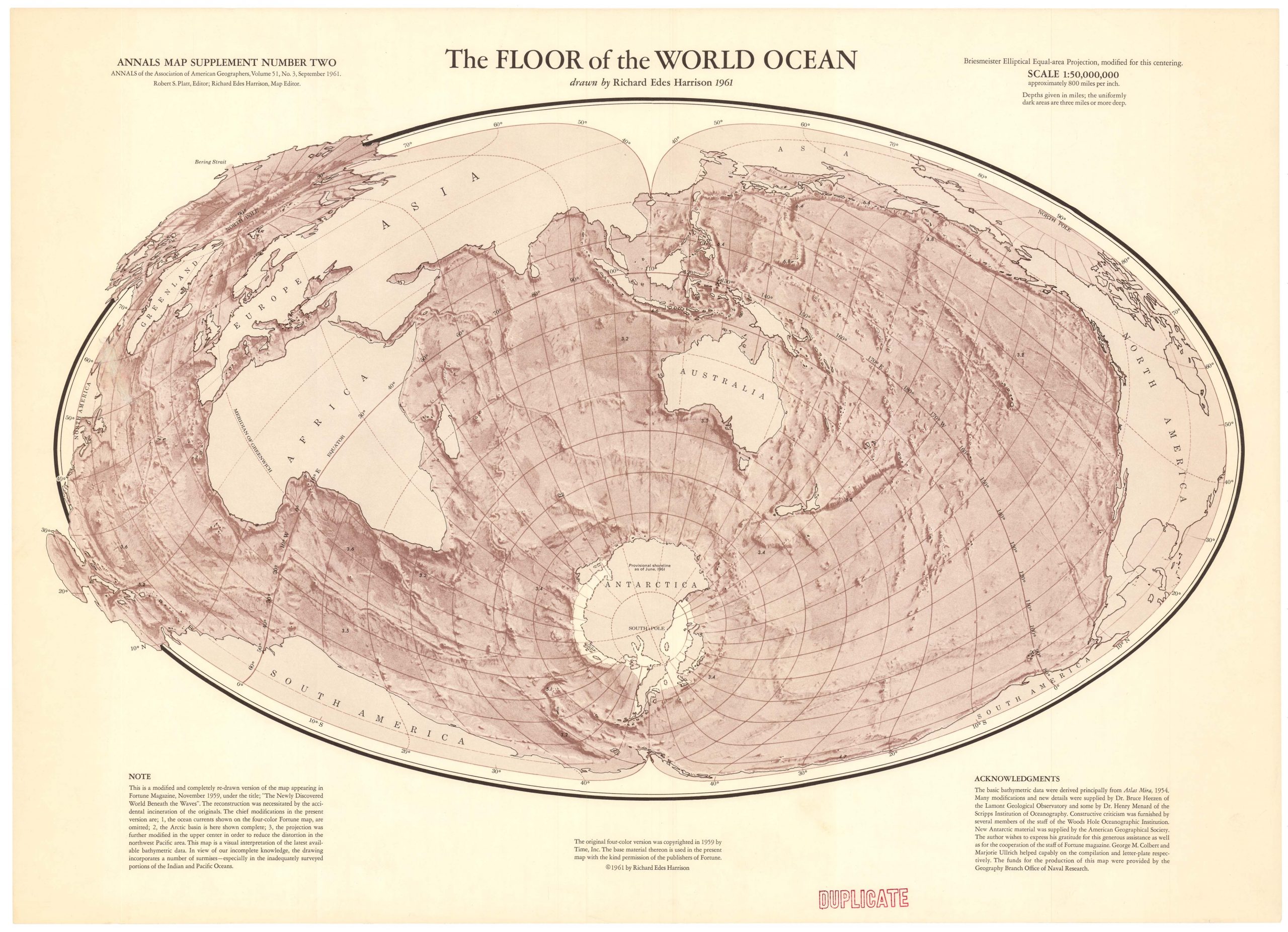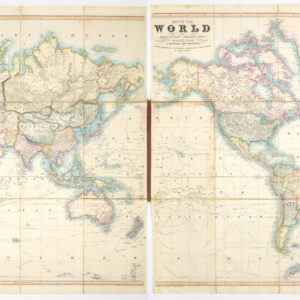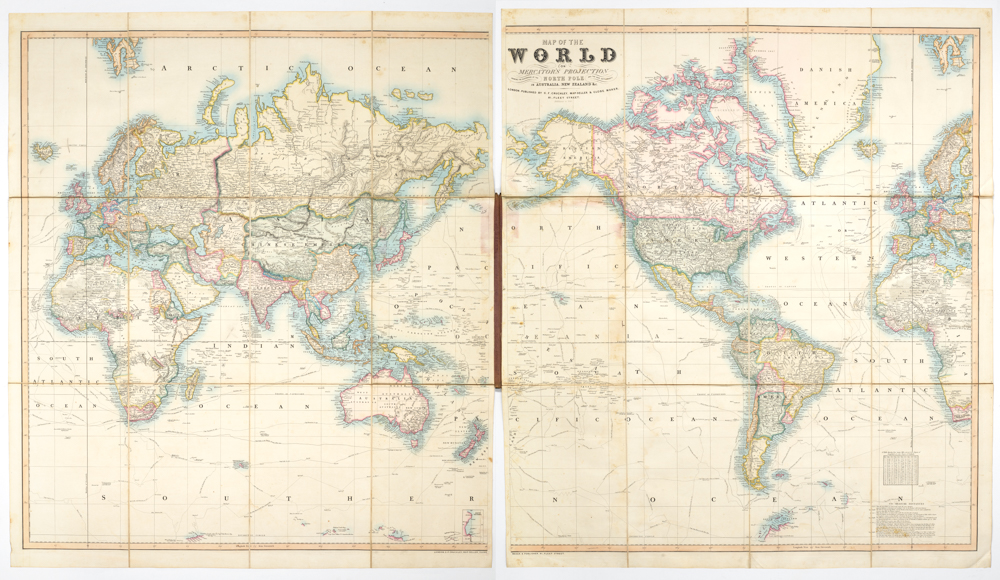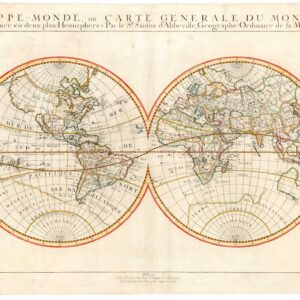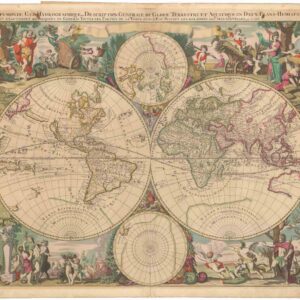The idealism of the United Nations represented visually.
United Nations Map of the World
Out of stock
Description
This is a copiously illustrated c. 1947 pictorial map of the world highlighting the recent creation of the United Nations by the British mapmaker John Bartholomew and Sons. The variety and richness of illustrations reflect the idealism that motivated the founding of the organization, as well as some of its inherent problems.
Seals around the map represent various founding members of the United Nations. The Soviet seal is notable for including ribbons for Ukraine and Byelorussia. To its immediate left is a seal with the date November 29, 1943, commemorating the Tehran Conference, the first face-to-face meeting between the “Big Three” of Stalin, Roosevelt, and Churchill. One of the items discussed at the meeting was the establishment of an organization of nations that would eventually become the U.N.
Text blocks at top-left and top-right include quotes from the Gettysburg Address and Leo Tolstoi, while text blocks towards the bottom include quotations from the Atlantic Charter and United Nations Declaration. Apparently feeling that the map did not already have enough information, panels along the right and left sides contrast various elements of ancient and modern life, such as timekeeping, power, and travel.
The map reflects the hope that universal values and norms could be agreed upon between nations, while also hinting at why such a project would be incredibly difficult. Unsurprisingly for a map made in 1947, it adopts a Euro-centric and especially Anglo-centric perspective, whitewashing the history of both European and British colonial history. The map is replete with paeons to European exploration, quotes from Western (mostly British) philosophical and literary figures, and Doric columns with banners listing the great thinkers of the Western Canon. Still, efforts were made to include non-Western cultures, which look patronizing to our eyes but were admirable for their time. Thus, in the Americas, the Inca and Aztecs are represented along with Native American figures in North America (who welcome Europeans), while illustrations in Asia refer to Mohammed and the Mughals.
Wartime allies of Great Britain are depicted sympathetically, particularly the Soviet Union, where the October Revolution, the First Five Year Plan, and Co-operative Farming are all celebrated. The text associated with China reproduces tropes from the Guomindang (Nationalist Party) playbook, including the valorization of Confucius and the claim of two millennia of unbroken civilization and imperial government. Conversely, the mushroom cloud over Japan and mention of the recent atomic bombings is a grim reminder of the recent conflict.
The origins of the United Nations lie in international agreements and organizations going back to the late 19th century, most of which had been rendered moot by the atrocities of the Second World War, as well as a wartime effort to find an underlying set of principles to motivate the otherwise ideologically disparate Allies. Several agreements in the early part of the European phase of the war (especially the Atlantic Charter and Declaration by United Nations, both 1941) floated ideas that were fleshed out in meetings between leaders and representatives of the Allies in the latter part of the war (during the war, the phrase ‘United Nations’ was synonymous with the Allies who were at war against the Axis powers). Then, in April-June 1945, before the war’s end, a United Nations Conference on International Organization was held in San Francisco that formally created the organization known today, with 51 founding member states. The organization held meetings in various places in Europe and the United States until a new headquarters was constructed in New York City, completed in 1951.
Despite high hopes that the organization could provide a common set of principles and basis for peace, events quickly proved that to be impossibly optimistic. An early major test for the organization was decolonization, which many of the member states supported but leading countries like the U.K, France, and, to an extent, the U.S., opposed. The related ideological conflict between Communist and non-Communist countries also challenged the U.N. early on. The Soviets, perhaps with reason, were deeply skeptical of the U.N. and saw it as a tool of Anglo-American power. Soviet-backed Communist revolutions around the decolonizing world, most notably in China, one of the “Big Four” wartime powers, and Western-backed counter-insurgencies and anti-Communist revolts did not fit neatly into the conception of unprovoked wars of aggression that the organization was meant to prevent.
However, the invasion of South Korea by Soviet-aligned North Korea was such a war of aggression, and in one of its most significant early actions, the U.N. formed a joint military command (dominated by the U.S.) to intervene in support of South Korea. This was possible because the Soviets were boycotting the U.N. at the time because of the Republic of China, which had lost mainland China to the Communists and retreated to Taiwan, continued to represent China at the U.N., including its seat on the Security Council. In the intervening years, the U.N. has continued to struggle with the question of whether it should promote a universal moral standard (rooted in Western liberal values) and, if so, how to set about enforcing that standard. This duality of the organization, as both an extension of Western liberalism, which itself was historically deeply intertwined with Western imperialism, and an institution aiming at universalism and neutrality, is evident in the map’s illustrations and text.
Census
This map is usually dated to 1947 and attributed to L.G. Bullock, who made several children’s maps for Bartholomew. The reference to the French Third Republic (rather than the Fourth, founded in late 1946) suggests that the map was drawn at some time in 1946. The map is noted in the OCLC as being held by five institutions worldwide and the David Rumsey Historical Map Collection (List No. 12490.002), which dates it to 1948 (probably due to an advertisement on the back cover for the 1948 edition of Bartholomew’s Regional Atlas of the World).
Cartographer(s):
John Bartholomew and Son Ltd. was a renowned Scottish map-making company, a family business that traced its roots back to the 19th century. The company was famous for its detailed and innovative cartography and played a significant role in the development of modern map-making techniques. They were particularly known for their detailed city plans, wall maps, and atlases and for pioneering the use of color contouring in topographical maps.
The Bartholomew firm’s work was highly respected for its accuracy, artistry, and craftsmanship, and the name Bartholomew became synonymous with high-quality maps not just in the United Kingdom but internationally. The company also produced a wide range of thematic maps, like the whiskey map of Scotland, which combined the firm’s cartographic skills with cultural and historical content.
Condition Description
This map is in good condition, with fold lines visible and some wear and imperfection in the margins, especially at the fold lines. Small pinholes are present at the bottom corners along the neatline.
References

